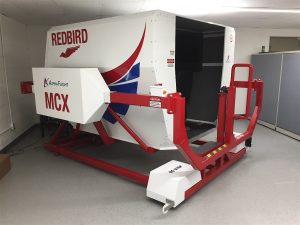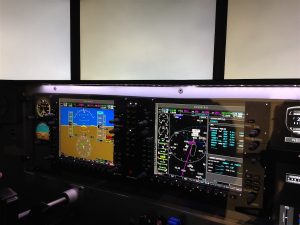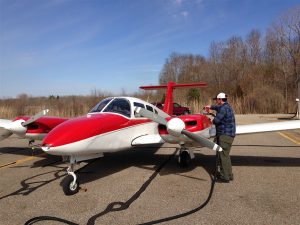MEI Training Times Included
- MEI Course Duration:
3 days of training, plus 1 day for FAA Practical Test. - Flight Training:
7 hours of multi engine flight instruction in a Piper PA-44-180 Seminole, equipped with a Garmin 500 PFD/MFD and a Garmin GTN 650 GPS. - FAA Practical Test:
Two hours of airplane rental for the practical test are included in the course price.
The examiner fee of $600 is payable directly to the examiner and is not included in the course price. - Ground Instruction:
Unlimited ground instruction on the above 3+1 MEI course days. Our profound, industrial-strength ground school is based on FAA and test pilot school textbooks. - Advanced Aviation Training Device (AATD, “flight simulator”):
Complementary free access to the Redbird MCX AATD with a multi engine configuration during your three days of training.
Note: Up to 25 hours of the Redbird time can be used towards the 1500 hours required for ATP certificate.
MEI Course Cost
Course Cost: $4295
Includes everything listed in the box on the left.Additional Flight Training Time:
For additional training time (if needed), the price is $279/hour for the Piper PA-44-180 Seminole and $59/hour for flight instruction.- Additional Ground Instruction:
Ground instruction during the original 3+1 MEI course days is unlimited. If ground instruction is needed on additional days, it is billed at $59/hour, or $295/half day, or $590/day. Complementary access to the Redbird MCX AATD is included for up to two additional days.
Day 1
- Morning:
2 hours of Redbird MCX AATD. Verification that you know all the maneuver procedures (and an opportunity to tie up loose ends); rehearsal of emergency procedures. - Afternoon:
1.5-hour upper airwork flight with instrument approach and 3 landings. Evening:
Ground instruction (review of multiengine theory) or Redbird MCX (instrument approach or multiengine procedure practice), as needed.
Day 2
Morning:
1.5-hour upper airwork flight with instrument approach and 3 landings.Afternoon:
1.5-hour upper airwork flight with instrument approach and 3 landings.Evening:
Ground instruction or Redbird MCX.
Day 3
Morning:
1.5-hour upper airwork flight with instrument approach and 3 landings.Afternoon:
1 hour flight: landing practice (or 2 instrument approaches, whichever needs more work).Evening:
Ground instruction (final checkride preparation with your multi engine instructor).
Day 4
- Morning or afternoon:
FAA Practical Test (typically at C65, but an alternate location may be chosen based on weather). Will add a multi engine instructor rating to your flight instructor certificate.
Weather Issues
If the weather does not allow flying on one of the days, the flight portion of your MEI training will be compressed into two days, and the bad weather day will be used for ground instruction, teaching practice, as well as for instrument and procedure exercises in the Redbird MCX AATD. If the weather prevents flying on two training days, the practical test will likely have to be postponed. Therefore, if the weather forecast is uncertain, you may elect to arrive for your MEI course one or two days early. If adverse weather prevails on the date of the practical test, the examiner typically reserves the subsequent day as a weather backup (though this is at the examiner’s discretion and depends on his schedule).
Candidate Preparation and Proficiency
This is an accelerated multi engine instructor course, for which you will need to come well prepared, in particular regarding theoretical knowledge, since teaching is involved. There are three components of preparedness:
Theoretical Knowledge
Since obtaining a multi engine instructor rating involves teaching, it will require you to have a solid command of the theory. Therefore, you must prepare at home before the course begins with the training materials which you will receive from us. We will also hold two 1-hour video conferences with you to help you come prepared.
During the course we will review all the ground school materials once, and then you will teach them to your multi engine instructor. If you do not know the content well in advance, you will not be able to retain enough during the first pass to allow you to teach during the second.
Furthermore, especially for your multi engine instructor rating, we would like to take you beyond just the necessary basics for the practical test, and dive into some test pilot school textbooks to produce an excellently trained new MEI. The more you know coming in, the more additional information we can impart on you, which is really one of our main training objectives, and which makes this multi engine instructor course stand out.
Airmanship
You must also be very proficient at airplane flying in general, as there will be no time to get you “back into it”. If you have not flown in the last three months, get some practice before the course.
On your first flight you will be asked to go through all the practical test maneuvers one by one, and you must already know all the procedures for them and execute them without being prompted for the individual steps. The flights are intended to give you practice to execute the maneuvers within ACS standards (in terms of altitude, heading, bank angle, and airspeed tolerance), not to teach you how to perform the maneuvers in principle. Each maneuver will be flown once on each flight, with the option of practicing a few of the weaker maneuvers a second time if needed; after that, we must move on to the next maneuver (you will get a chance to practice each maneuver on the next flight again).
Instrument Flight
You must be proficient at instrument flight, because you will be required to fly a one-engine-inoperative instrument approach on your practical test. Whether you are formally current and/or had a recent IPC is immaterial; some people successfully prepare with the flight simulator on their home computer. All you need is to be proficient at instrument approaches – IFR clearances and departure/en route procedures are not required.
Each of your upper airwork training flights will end in an instrument approach. While we can do a couple of hours of simulator work to get you used to the avionics layout, in the airplane you will get to fly 4 instrument approaches during the course: generally two LPV (GPS) precision approaches and two VOR approaches (though we recommend you nail the VOR the first time and get yourself a third LPV instead). A fifth instrument approach may be doable if you are good at landings and want to do one instead of the landing practice flight. Any more practice will require extra flight time.
Summary
Unless you have studied all the training materials diligently beforehand and come exquisitely prepared, you will need more flight time (and more ground instruction as well). Also, review your past multiengine training thoroughly, before you arrive, to connect the material to what you already know. As a future MEI, you must be very solid on the theory.
We do not promise you will finish in the time advertised; we merely provide you with an environment where you can, if you apply yourself, as other candidates have done before you, and we make it our personal goal to assist you as much as possible. If you are proficient at teaching and understand multiengine theory, this MEI course is generally easier than our accelerated multi engine add-on course of equal length, because learning to fly from the right seat is not as challenging as learning multiengine for the first time. The flying part of the FAA practical test tends to be a little bit easier as well (though the oral portion is more thorough).
References
In addition to our proprietary multi engine instructor training materials, which we will send you ahead of time, you may wish to consult the the following references (all available in the public domain):
FAA Publications:
- “Pilot’s Handbook of Aeronautical Knowledge,” FAA-H-8083-25B, U.S. Department of Transportation, Federal Aviation Administration, Flight Standards Service, Washington D.C., 2016.
https://www.faa.gov/regulations_policies/handbooks_manuals/aviation/phak/ - “Airplane Flying Handbook,” FAA-H-8083-3B, U.S. Department of Transportation, Federal Aviation Administration, Flight Standards Service, Washington D.C., 2016.
https://www.faa.gov/regulations_policies/handbooks_manuals/aviation/airplane_handbook/ - “Flight Instructor Practical Test Standards for Airplane,” FAA-S-8081-6D (with Changes 1-6), U.S. Department of Transportation, Federal Aviation Administration, Flight Standards Service, Washington D.C., June 2012.
https://www.faa.gov/training_testing/testing/test_standards/media/faa-s-8081-6d.pdf
Test Pilot School Textbooks: (optional)
- “U.S. Naval Test Pilot School Flight Test Manual: Fixed Wing Stability and Control –Theory and Flight Test Technique,” USNTPS-FTM-No. 103, Naval Air Warfare Center, Aircraft Division, Patuxent River, Maryland, January 1997.
http://www.usntpsalumni.com/Resources/Documents/USNTPS_FTM_103.pdf - USAF Test Pilot School, “Flying Qualities Textbook,” Volume II, Part 2, USAF-TPS-CUR-86-03, Edwards AFB, California, April 1986, (Chapter 11).
http://www.dtic.mil/dtic/tr/fulltext/u2/a170960.pdf




